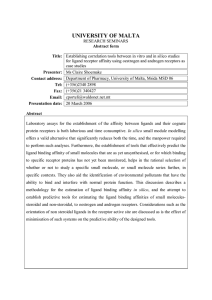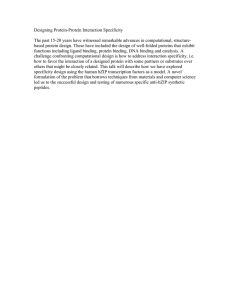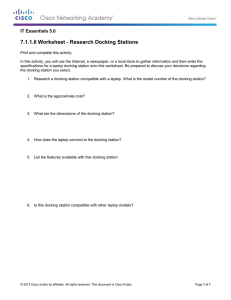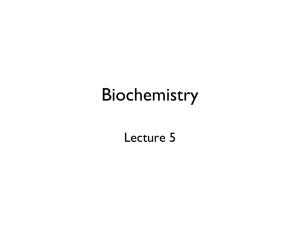Document 13309964
advertisement
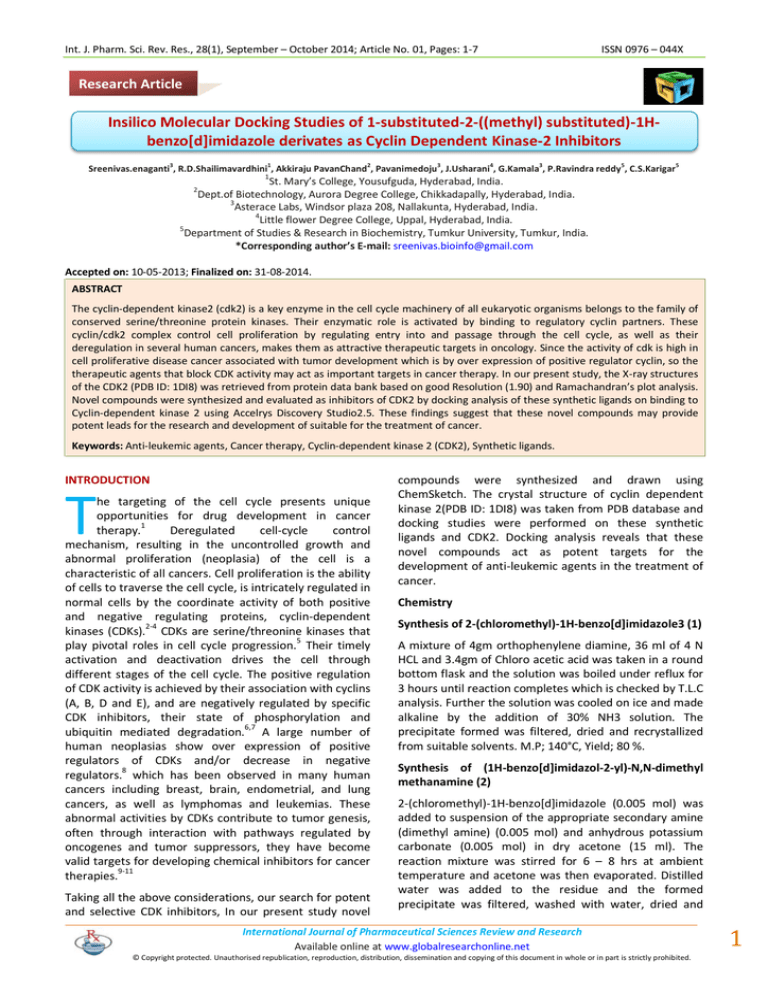
Int. J. Pharm. Sci. Rev. Res., 28(1), September – October 2014; Article No. 01, Pages: 1-7 ISSN 0976 – 044X Research Article Insilico Molecular Docking Studies of 1-substituted-2-((methyl) substituted)-1Hbenzo[d]imidazole derivates as Cyclin Dependent Kinase-2 Inhibitors 3 1 2 3 4 3 5 Sreenivas.enaganti , R.D.Shailimavardhini , Akkiraju PavanChand , Pavanimedoju , J.Usharani , G.Kamala , P.Ravindra reddy , C.S.Karigar 5 1 St. Mary’s College, Yousufguda, Hyderabad, India. Dept.of Biotechnology, Aurora Degree College, Chikkadapally, Hyderabad, India. 3 Asterace Labs, Windsor plaza 208, Nallakunta, Hyderabad, India. 4 Little flower Degree College, Uppal, Hyderabad, India. 5 Department of Studies & Research in Biochemistry, Tumkur University, Tumkur, India. *Corresponding author’s E-mail: sreenivas.bioinfo@gmail.com 2 Accepted on: 10-05-2013; Finalized on: 31-08-2014. ABSTRACT The cyclin-dependent kinase2 (cdk2) is a key enzyme in the cell cycle machinery of all eukaryotic organisms belongs to the family of conserved serine/threonine protein kinases. Their enzymatic role is activated by binding to regulatory cyclin partners. These cyclin/cdk2 complex control cell proliferation by regulating entry into and passage through the cell cycle, as well as their deregulation in several human cancers, makes them as attractive therapeutic targets in oncology. Since the activity of cdk is high in cell proliferative disease cancer associated with tumor development which is by over expression of positive regulator cyclin, so the therapeutic agents that block CDK activity may act as important targets in cancer therapy. In our present study, the X-ray structures of the CDK2 (PDB ID: 1DI8) was retrieved from protein data bank based on good Resolution (1.90) and Ramachandran’s plot analysis. Novel compounds were synthesized and evaluated as inhibitors of CDK2 by docking analysis of these synthetic ligands on binding to Cyclin-dependent kinase 2 using Accelrys Discovery Studio2.5. These findings suggest that these novel compounds may provide potent leads for the research and development of suitable for the treatment of cancer. Keywords: Anti-leukemic agents, Cancer therapy, Cyclin-dependent kinase 2 (CDK2), Synthetic ligands. INTRODUCTION T he targeting of the cell cycle presents unique opportunities for drug development in cancer therapy.1 Deregulated cell-cycle control mechanism, resulting in the uncontrolled growth and abnormal proliferation (neoplasia) of the cell is a characteristic of all cancers. Cell proliferation is the ability of cells to traverse the cell cycle, is intricately regulated in normal cells by the coordinate activity of both positive and negative regulating proteins, cyclin-dependent kinases (CDKs).2-4 CDKs are serine/threonine kinases that play pivotal roles in cell cycle progression.5 Their timely activation and deactivation drives the cell through different stages of the cell cycle. The positive regulation of CDK activity is achieved by their association with cyclins (A, B, D and E), and are negatively regulated by specific CDK inhibitors, their state of phosphorylation and 6,7 ubiquitin mediated degradation. A large number of human neoplasias show over expression of positive regulators of CDKs and/or decrease in negative regulators.8 which has been observed in many human cancers including breast, brain, endometrial, and lung cancers, as well as lymphomas and leukemias. These abnormal activities by CDKs contribute to tumor genesis, often through interaction with pathways regulated by oncogenes and tumor suppressors, they have become valid targets for developing chemical inhibitors for cancer therapies.9-11 Taking all the above considerations, our search for potent and selective CDK inhibitors, In our present study novel compounds were synthesized and drawn using ChemSketch. The crystal structure of cyclin dependent kinase 2(PDB ID: 1DI8) was taken from PDB database and docking studies were performed on these synthetic ligands and CDK2. Docking analysis reveals that these novel compounds act as potent targets for the development of anti-leukemic agents in the treatment of cancer. Chemistry Synthesis of 2-(chloromethyl)-1H-benzo[d]imidazole3 (1) A mixture of 4gm orthophenylene diamine, 36 ml of 4 N HCL and 3.4gm of Chloro acetic acid was taken in a round bottom flask and the solution was boiled under reflux for 3 hours until reaction completes which is checked by T.L.C analysis. Further the solution was cooled on ice and made alkaline by the addition of 30% NH3 solution. The precipitate formed was filtered, dried and recrystallized from suitable solvents. M.P; 140°C, Yield; 80 %. Synthesis of (1H-benzo[d]imidazol-2-yl)-N,N-dimethyl methanamine (2) 2-(chloromethyl)-1H-benzo[d]imidazole (0.005 mol) was added to suspension of the appropriate secondary amine (dimethyl amine) (0.005 mol) and anhydrous potassium carbonate (0.005 mol) in dry acetone (15 ml). The reaction mixture was stirred for 6 – 8 hrs at ambient temperature and acetone was then evaporated. Distilled water was added to the residue and the formed precipitate was filtered, washed with water, dried and International Journal of Pharmaceutical Sciences Review and Research Available online at www.globalresearchonline.net © Copyright protected. Unauthorised republication, reproduction, distribution, dissemination and copying of this document in whole or in part is strictly prohibited. 1 © Copyright pro Int. J. Pharm. Sci. Rev. Res., 28(1), September – October 2014; Article No. 01, Pages: 1-7 recrystallized from appropriate solvent. The purity of the compound was checked by TLC and spectral data. M.P; 160o C, Yield; 68 %. IR (KBr)(cm-1): 3075(N-H str.), 3155 (Ar-H str.), 1650-1540 (C=C & C=N str.). H1 NMR (DMSOd6): δ 5.2, (s, 1H, NH), 8.1-7.2 (m, 4H, Ar-H), 3.4 (s, 2H, CH2-), 2.3 (s, 6H, -N(CH3)2). EI-MS: m/z = 175(M+), 176 (M+1). Synthesis of (4-chloropyridin-2-yl)(2-((dimethylamino) methyl)-1H-benzo[d]imidazol-1-yl) methanone (3) A solution of 2 (0.005 mol) in dry N,N-dimethyl formamide was treated with potassium tert-butoxide and the reddish brown mixture was stirred at room temperature for 2 hr. The contents were treated with 4chloropyridine-2-carbonyl chloride (0.005 mol) and potassium carbonate and then heated to 80oC for 6 hr. The mixture was cooled to room temperature and poured into ethyl acetate. The combined organics were washed with brine, dried over sodium sulphate and concentrated to give (4-chloropyridin-2-yl) (2-((dimethylamino) methyl)-1H-benzo[d]imidazol-1-yl) methanone. M.P; 220o C, Yield; 63 %. IR (KBr) (cm-1): 3155 (Ar-H str.), 1610-1530 (C=C & C=N str.), 1240 (C-N), 1648 (C=O), 745 (C-Cl). H1NMR (DMSO-d6): δ 9.4 -7.2 (m, 7H, Ar-H), 3.8 (s, 2H, CH2-), 2.5 (s, 6H, -N(CH3)2). EI-MS: m/z = 314(M+), 315(M+1). Methodology Protein preparation The high resolution x-ray crystal structure of cyclin dependent kinase 2 was obtained from the protein databank. After evaluating number of entries, the best protein was selected based on high resolution, Ramachandran plot analysis, and Procheck using SAVS server based on number of residues in disallowed regions (Laskowaski et al., 1993). Using Accelrys Discovery studio 3.0 protein preparation was carried out by correcting the missing residues and the removing the complexes bound to receptor molecule. The structure was then refined by energy minimization with appropriate charges and parameters carried out using steepest descent gradient until the convergence gradient satisfied. Ligand preparation and optimization 12 Using ACD/ ChemSketch (12.0) Software the structures of the 34 synthetic ligand compounds i.e B-3 to B-36 compounds, were drawn and saved in mol2 format. The saved ligand compounds were later imported and minimized in Argus Lab after adding hydrogen bonds. The molecules thus obtained were saved in mol format. Molecular Docking using Discovery Studio 2.5 Docking of ligands in to a receptor biding site was done by CDOCKER in Accelrys Discovery Studio which uses a CHARMm-based molecular dynamics (MD) scheme. Random ligand conformations are generated using hightemperature MD which is then translated into the binding site. Candidate poses are then created using random ISSN 0976 – 044X rigid-body rotations followed by simulated annealing. A final minimization is then used to refine the ligand poses.13 The binding mode for all 29 ligands to Cyclindependent kinase 2 (CDK2) (PDB ID: 1DI8) was investigated by CDOCKER protocol which had been incorporated into Discovery Studio 2.5. The Binding-Site module (Accelrys Inc.) is a suite of programs for identifying and characterizing protein active sites, binding sites, and functional residues from protein structures and multiple sequence alignments. Two site finding routines are used to automatically locate binding sites. One identifies cavities within the receptor, the other builds a binding site based on a ligand molecule already in a known location. The algorithm for both is based on a grid search and "eraser" algorithm. The results can be used to guide the protein–ligand docking experiment. RESULTS AND DISCUSSION Selection of PDB Structure Based on good resolution and Ramachandran’s plot analysis the X-ray crystal structure of the protein Cyclindependent kinase 2 (PDB ID: 1DI8) was retrieved from protein data bank. The crystal structures of the human cyclin-dependent kinase 2(CDK2) in complex with 4-[3hydroxyanilino]-6,7-dimethoxyquinazoline [14] have been determined to 2.20 Å resolutions with sequence length of 298 base pairs. The structure is bi-lobate, like that of the cyclic AMP-dependent protein kinase, but contains a unique helix-loop segment that interferes with ATP and protein substrate binding and probably plays a key part in the regulation of all cyclin-dependent kinases. Figure 1: The structure of cyclin-dependent kinase 2 (cdk2) in complex with 4-[3-hydroxyanilino]-6,7dimethoxyquinazoline. Active Site Analysis of 1DI8 Structure The structure was further analyzed for identifying the possible binding sites of Cyclin-dependent kinase 2 (CDK2) (Figure 3). Using Accelrys Discovery Studio software package docking was performed to find out the appropriate binding orientations and conformations of ligands on 1DI8.15 The receptor molecule is first defined by using binding site tools of Discovery Studio. In this study, Active Site-Search was used to identify protein active sites and binding sites by locating cavity in the 1DI8 structure. When the search was completed, the largest International Journal of Pharmaceutical Sciences Review and Research Available online at www.globalresearchonline.net © Copyright protected. Unauthorised republication, reproduction, distribution, dissemination and copying of this document in whole or in part is strictly prohibited. 2 © Copyright pro Int. J. Pharm. Sci. Rev. Res., 28(1), September – October 2014; Article No. 01, Pages: 1-7 site was automatically displayed on the structure. And then, by using Asite-Display, other sites were also obtained. ISSN 0976 – 044X the poses to the receptor molecule and close contacts (Vander Waals clashes) between the poses and receptor molecule. As it is well known, H bonds play an important role for the structure and function of biological molecules, especially for the enzyme catalysis. The H bonds present in the protein-ligand complex are shown in (Figure 4). In this study, it was found that ARG297 of receptor molecule (i.e. 1DI8) forms one Hbonds with oxygen atom of 7th synthetic ligand. Similarly GLY98, PRO100, HIS295 forms non-bonding interactions at active site pocket 2 of the receptor molecule. Figure 2: Identification of active site pocket in receptor molecule Figure 4: Docking model of active site residues of CDK2 with 7 mol ligand DISCUSSION Figure 3: Defining of sphere around active site pocket 2 DOCKING Docking of Synthetic ligands with 1DI8 structure: CDOCKER is a grid-based molecular docking method that employs CHARMm (Brooks et al., 1983). The receptor was held rigid while the ligand was allowed to flex during the refinement. By the search mentioned above, prior knowledge of the binding site had been acquired. Hence it was possible to specify the ligand placement in the active site using a binding site sphere with the radius of 12A˚ (Figure 4). The CDOCKER interaction energy between the compounds and 1DI8 (E-binding) was finally computed. From the docking analysis, insights into the interactions between the ligands and the receptor were gained, which facilitated the selection of top 10 poses which were saved for comparison and analysis. Finally, the pose with the lowest CDOCKER energy was used for further study. The default parameters were used in the docking simulations with CDOCKER. Different Poses of proteinligand complex is obtained after docking process with their specific CDOCKER energy and CDOCKER interaction scores displayed in output file. The best ligand was chosen on the basis of their highly interacting amino acid residues (Table 1). The ligand poses were analyzed and interaction of ligand molecule with the 1DI8 protein structure was studied on the basis of H-bonding made by Our compounds are likely inhibiting CDK as one of the important drug target in the cancer therapy. The X-ray crystal structure of the protein human Cyclin-dependent kinase 2 (PDB ID: 1DI8) in complex with 4-[3hydroxyanilino]-6,7-dimethoxyquinazoline were retrieved from protein data bank based on good resolution of 2.20 Å with sequence length of 298 base pairs and The structure was analyzed for identifying the possible binding sites of Cyclin-dependent kinase 2 (CDK2) (Figure 2). 2D structures of the synthetic ligand compounds (B-3 to B-36) were generated using ChemSketch and subjected to energy minimization using Argus lab. Docking of these optimized compounds against Cyclin-dependent kinase 2 (1DI8) structures at the catalytic active site residues were performed by Accelrys Discovery Studio 2.5. To locate the appropriate binding orientations and conformations of ligands on 1DI8, molecular docking was performed by using CDOCKER. The CDOCKER interaction energy between the synthetic ligand compounds and protein receptor 1DI8 (E-binding) was finally computed. Out of 34 docked complexes, we got 1 best docked synthetic compound showing highest H-bond interactions & lowest CDOCKER energy with the amino acid residues of the receptor molecule (Table 1). The H-bond interaction of best docked complex is shown in Figure 4. It is evident from this analysis that the best inhibitors are located in the center of the active site and is stabilized by hydrogen bonding interactions. As it’s well known, hydrogen bonding plays an important role for the structure and function of biological molecules, especially for inhibition in a complex. International Journal of Pharmaceutical Sciences Review and Research Available online at www.globalresearchonline.net © Copyright protected. Unauthorised republication, reproduction, distribution, dissemination and copying of this document in whole or in part is strictly prohibited. 3 © Copyright pro Int. J. Pharm. Sci. Rev. Res., 28(1), September – October 2014; Article No. 01, Pages: 1-7 ISSN 0976 – 044X Table 1: Physical data & CDOCKER energy interaction of synthesized compounds (B-3 – B-36) with CDK2 protein (1DI8) at active site pocket 2 Compound R1 R2 Mol. Wt. CDOCKER Energy CDOCKER Interaction Energy C18 H19ClN4O 342.82 -3.29681 30.3914 C16 H15ClN4O 314.77 -0.399646 32.3641 C19 H21ClN4O 356.85 -5.10712 29.2814 C26 H19ClN4O 438.91 -4.90609 30.9103 C26 H31ClN4O 451 -43.288 22.0734 C19H19ClN4O 354.83 -11.0752 30.7617 C19 H20ClN5O 369.85 -11.1349 34.2819 C20 H14ClN3OS 379.86 -5.81713 29.5668 C22 H17ClN4O2 404.85 -4.26403 32.5233 C19 H17ClN4O2 368.82 -6.986 30.1902 C18 H17ClN4O2 356.81 -9.58124 30.7904 O C2H5 B-3 Mol. Formula N N C2H5 Cl CH3 O N B-4 N CH3 Cl C2H5 B-5 O N N C3H7 Cl O B-6 N N Cl O B-7 N N Cl O B-8 N N Cl O B-9 N N CH3 N Cl O B-10 S N Cl COCH3 B-11 O N N Cl O B-12 N O N Cl O B-13 N O N Cl International Journal of Pharmaceutical Sciences Review and Research Available online at www.globalresearchonline.net © Copyright protected. Unauthorised republication, reproduction, distribution, dissemination and copying of this document in whole or in part is strictly prohibited. 4 © Copyright pro Int. J. Pharm. Sci. Rev. Res., 28(1), September – October 2014; Article No. 01, Pages: 1-7 O CH3 B-14 ISSN 0976 – 044X N N C21 H17ClN4O 376.84 -4.98781 27.6649 C20 H20ClN5O2 397.86 -3.69185 35.8494 C17 H12ClN5O 337.76 -2.282 30.3436 C18 H14ClN5O 351.79 1.7189 30.6319 C18 H17ClN4O 340.81 -17.0205 33.3479 C18 H13ClN4O 336.78 -2.44068 30.7775 C19 H23N5O 337.42 1.18617 34.553 C17 H19N5O 309.37 2.52818 31.5818 C20 H25N5O 351.45 1.25762 31.575 C27 H23N5O 433.5 -5.23282 29.3869 C19 H35N5O 445.6 -44.7338 28.1144 C20 H23N5O 349.43 -6.33888 28.5135 C20 H24N6O 364.44 -7.04899 31.949 Cl O B-15 N N COCH3 N Cl O N B-16 N N Cl CH3 B-17 O N N N Cl O B-18 N N Cl O N B-19 N Cl C2H5 N B-20 C2H5 N CONHCH3 CH3 N B-21 CH3 N CONHCH3 C2H5 B-22 N C3H7 B-23 N N N B-24 CONHCH3 N N B-25 CONHCH3 N N B-26 CONHCH3 N N CONHCH3 CH3 N CONHCH3 International Journal of Pharmaceutical Sciences Review and Research Available online at www.globalresearchonline.net © Copyright protected. Unauthorised republication, reproduction, distribution, dissemination and copying of this document in whole or in part is strictly prohibited. 5 © Copyright pro Int. J. Pharm. Sci. Rev. Res., 28(1), September – October 2014; Article No. 01, Pages: 1-7 B-27 S N ISSN 0976 – 044X C21 H18N4OS 374.46 1.97034 29.131 C23 H21N5O2 399.45 -0.618252 30.5434 C20 H21N5O2 363.41 -1.17912 30.3505 C19 H21N5O2 351.4 -3.72093 26.6278 C22 H21N5O 371.44 1.15408 27.2038 C21 H24N6O2 392.45 -3.01997 25.4988 C18 H16N6O 332.36 1.40656 25.7671 C19 H18N6O 346.39 5.76038 29.0931 C19 H21N5O 335.4 -13.9 27.8714 C19 H17N5O 331.37 2.44898 28.1617 CONHCH3 COCH3 B-28 N N B-29 N O N B-30 CONHCH3 N CONHCH3 O N CONHCH3 CH3 B-31 N N B-32 N N COCH3 N B-33 CONHCH3 CONHCH3 N N N CONHCH3 CH3 B-34 N N N B-35 CONHCH3 N N CONHCH3 N B-36 N CONHCH3 CONCLUSION The present study demonstrated the selection of X-ray crystal structure of human Cyclin-dependent kinase 2 (PDB ID: 1DI8) from Protein Data Bank. Among 80 different structures, 1DI8 is chosen as it was having maximum residues (89.4%) lie in the most favoured and no residues in disallowed region of Ramachandran plot. Further the structure was used to find the best inhibitors by studying the interaction between 1DI8 protein receptor and twenty-nine synthetic ligand compounds. Previous studies have shown that loss of CDK1 activity or the aberrant expression of CDK1 involved in G2 phase arrest and many tumor types, thereby validating CDK1 as a therapeutic target. Therefore, a surge of interest has been devoted to searching for potent CDK1 inhibitors as effective chemotherapeutic agents. Herein we focus, in this review, mainly on the studies about the structure, different structure classes & binding activity of potent synthetic ligand compounds as CDK1 inhibitors. Based on th the docking score, 7 ligand has shown lowest CDOCKER energy & best binding activity with our protein receptor. International Journal of Pharmaceutical Sciences Review and Research Available online at www.globalresearchonline.net © Copyright protected. Unauthorised republication, reproduction, distribution, dissemination and copying of this document in whole or in part is strictly prohibited. 6 © Copyright pro Int. J. Pharm. Sci. Rev. Res., 28(1), September – October 2014; Article No. 01, Pages: 1-7 th Thus our study confirms that, out of 34 compounds, 7 ligand compound based on bonding & non-bonding interaction could be potentially act as a drug candidate’s yet pharmacological study will yet confirm it to be promising. This study could be utilized for the designing of effective drug for the treatment of cancer. REFERENCES 1. Sherr CJ, Roberts JM, CDK inhibitors: Positive and negative regulators of G1-phase progression, Genes Dev, 13, 1999, 1501-12. 2. Draetta G, cdc2 activation; The interplay of cyclin binding and Thr 161 phosphorylation, Trends Cell Biol, 3, 1993, 287289. 3. Pines J, The cell cycle kinases, Semin Cancer Biol., 5, 1994, 305-313. 4. Hunter T, Pines J, Cyclins and cancer II: cyclin D and cdk inhibitors come of age, Cell, 79, 1994, 573-582. 5. Morgan DO, Cyclin-Dependent Kinases: Engines, Clocks, and Microprocessors, Annu. Rev. Cell Dev. Biol., 13, 1997, 261-291. 6. 7. Malumbres M, Barbacid M, Mammalian cyclin-dependent kinases, Trends Biochem. Sci., 30, 2005, 630-641. Harper JW, Adams PD, Cyclin-dependent kinases, Chem. Rev., 101, 2001, 2511-2526. ISSN 0976 – 044X 8. Carnero A, Targeting the cell cycle for cancer therapy, Br. J. Cancer, 87, 2002, 129-133. 9. Fischer PM, Lane DP, Inhibitors of cyclin-dependent kinases as anticancer Therapeutics, Curr Med Chem 7, 2000, 1213– 1245. 10. Sielecki TM, Boylan JF, Benfield PA, Trainor GL, Cyclindependent kinase inhibitors: useful targets in cell cycle regulation, J Med Chem, 43, 2000, 1–18. 11. Meijer L, Leclerc S, Leost M, Properties and potentialapplications of chemical inhibitors of cyclin-dependent kinases, Pharmacol Ther, 82, 1999, 279–284. 12. Alex MJ, Docking studies on anticancer drugs for breast cancer using Hex, Proceedings of the International Multi conference of Engineers and Computer Scientists, 1, 2009, 250-253. 13. Wu G, Robertson DH, Brooks CL III, Vieth M, Detailed Analysis of Grid-Based Molecular Docking: A Case Study of CDOCKER - A CHARMm-Based MD Docking Algorithm, J. Comp. Chem, 24, 2003, 1549-1562. 14. Shewchuk L, Hassell A, Wisely B, Rocque W, Holmes W, Veal J, Kuyper LF, J Med Chem., 43, 2000, 133-138. PubMed: 10633045. 15. Wu G, Robertson DH, Brooks CL III, Vieth M, Detailed Analysis of Grid-Based Molecular Docking: A Case Study of CDOCKER - A CHARMm-Based MD Docking Algorithm. J. Comp. Chem. 2003, 24, 1549-1562. Source of Support: Nil, Conflict of Interest: None. International Journal of Pharmaceutical Sciences Review and Research Available online at www.globalresearchonline.net © Copyright protected. Unauthorised republication, reproduction, distribution, dissemination and copying of this document in whole or in part is strictly prohibited. 7 © Copyright pro



